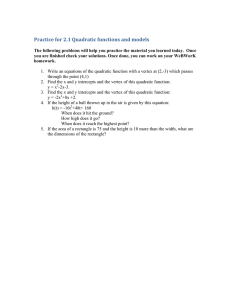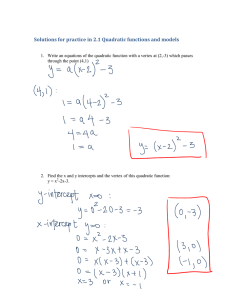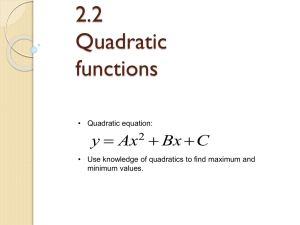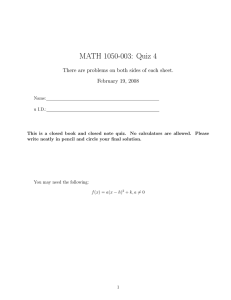fx ax bx c = + +
advertisement
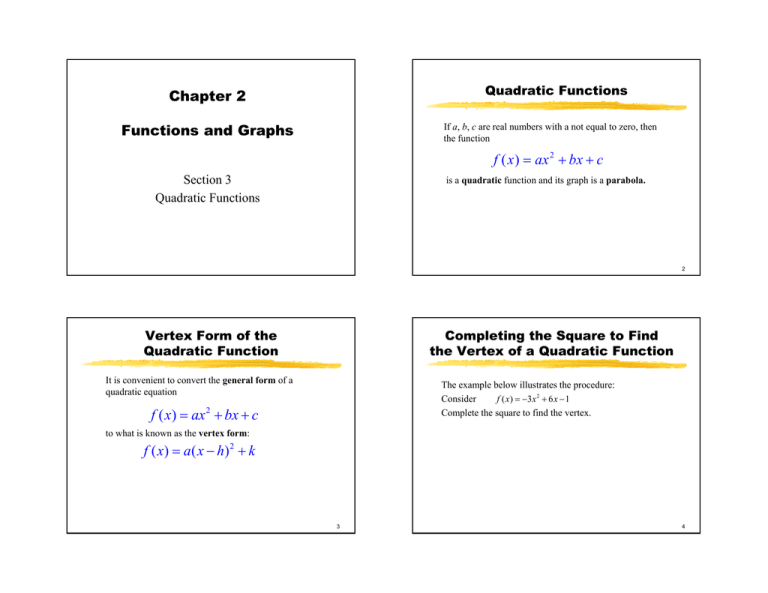
Quadratic Functions
Chapter 2
Functions and Graphs
If a,, b,, c are real numbers with a not equal
q to zero,, then
the function
f ( x ) = ax 2 + bx + c
Section 3
Quadratic Functions
Q
is a quadratic function and its graph is a parabola.
2
Vertex Form of the
Quadratic Function
Completing the Square to Find
the Vertex of a Quadratic Function
It is convenient to convert the general form of a
quadratic
d ti equation
ti
The example
p below illustrates the pprocedure:
f ( x ) = −3 x 2 + 6 x − 1
Consider
Complete the square to find the vertex.
f ( x) = ax 2 + bx + c
to what is known as the vertex form:
f ( x ) = a ( x − h) 2 + k
3
4
Completing the Square to Find
the Vertex of a Quadratic Function
Completing the square
(continued)
Add 1 to complete the square inside the parentheses. Because
off the
th –33 outside
t id the
th parentheses,
th
we have
h
actually
t ll added
dd d –3,
3
so we must add +3 to the outside.
The example
p below illustrates the procedure:
p
2
f ( x ) = −3 x + 6 x − 1
Consider
Complete the square to find the vertex.
f (x) = –3(x2 – 2x +1) –1+3
f (x) = –3(x – 1)2 + 2
Solution:
Factor the coefficient of x2 out of the first two terms:
Th
The vertex is
i (1,
(1 2)
The quadratic function opens down since the coefficient of the
x2 term is –3, which is negative.
f (x) = –3(x2 – 2x) –1
5
6
Intercepts of a Quadratic Function
Intercepts of a Quadratic Function
Find the x and y intercepts of
Find the x and y intercepts of
f ( x) = −3 x + 6 x − 1
f ( x) = −3 x 2 + 6 x − 1
2
x intercepts: Set f (x) = 0:
0 = −3 x 2 + 6 x − 1
quadratic formula:
Use the q
−b ± b 2 − 4ac
2a
x=
7
−6 ± 62 − 4(−3)(−1) −6 ± 24
=
≈ 0.184,1.816
2(−3)
−6
=
8
Generalization
Intercepts of a Quadratic Function
For
y intercept: Let x = 0.
0 If x = 0,
0 then y = –1
1, so (0
(0, –1)
1)
is the y intercept.
f ( x) = a ( x − h) 2 + k
If a ≠ 0, then the graph of f is a parabola.
• If a > 0, the graph opens upward.
• If a < 0, the graph opens downward. Vertex is (h , k)
Axis of symmetry: x = h
f (h) = k is the minimum if a > 0,
0 otherwise the maximum
Domain = set of all real numbers
Range: { y y ≤ k } if a < 0. If a > 0, the range is { y y ≥ k}
f ( x) = −3 x 2 + 6 x − 1
f (0) = −3(0) 2 + 6(0) − 1
9
Generalization
10
Solving Quadratic Inequalities
Solve the quadratic inequality –xx2 + 5x + 3 > 0 .
11
12
Application of Quadratic Functions
Solving Quadratic Inequalities
Solve the quadratic inequality –xx2 + 5x + 3 > 0 .
A Macon, Georgia,
G
i peachh orchard
h d farmer
f
now has
h 20
trees per acre. Each tree produces, on the average,
300 peaches. For each additional tree that the farmer
plants, the number of peaches per tree is reduced by
10. How many more trees should the farmer plant to
achieve the maximum yield of peaches? What is the
maximum yield?
Answer: This inequality holds for those values of x for
which the graph of f (x) is at or above the x axis. This
happens for x between the
two x intercepts, including
the intercepts. Thus, the
solution set for the
quadratic inequality is
– 0.5414 < x < 5.5414 or
[– 0.5414, 5.5414 ] .
13
14
Solution
(continued)
Solution
Let x represent the number of additional trees.
trees
2
Then Yield =( 300 – 10x) (20 + x)=− 1 0 x + 1 0 0 x + 6 0 0 0
To find the maximum yield, note that the Y (x) function is a
quadratic function opening downward. Hence, the vertex
of the function will be the maximum value of the yield.
Graph is below, with the y value in thousands.
Solution:
Yield = (number of peaches per tree) × (number of trees)
Yield = 300 × 20 = 6000 (currently)
Plant one more tree: Yield = ( 300 – 1(10)) × ( 20 + 1) =
290 × 21 = 6090 peaches.
Plant two more trees:
Yield = ( 300 – 2(10) × ( 20 + 2) = 280 x 22 = 6160
15
16
Solution
(continued)
Solution
(continued)
Y (x) =−10(( x − 5))
Complete the square to find the vertex of the parabola:
2
+ 6250
Y (x) = −10( x 2 − 10 x + 25) + 6000 + 250
Thus, the vertex of the quadratic function is (5 , 6250) . So,
the farmer should plant 5 additional trees and obtain a
yield of 6250 peaches. We know this yield is the maximum
off the
th quadratic
d ti function
f ti since
i
the
th the
th value
l off a is
i –10.
10
The function opens downward, so the vertex must be the
maximum.
We have to add 250 on the outside since we multiplied –10
by 25 = –250.
17
Break-Even Analysis
18
Solution to Break-Even Problem
The financial department of a company that produces digital
cameras has the revenue and cost functions for x million
cameras are as follows:
Set R(x) equal to C(x):
x(94.8 – 5x) = 156 + 19.7x
–5x2 + 75.1x – 156 = 0
R(x) = x(94.8 – 5x)
C(x) = 156 + 19.7x. Both have domain 1 < x < 15
x=
points are the pproduction levels at which
Break-even p
R(x) = C(x). Find the break-even points algebraically to the
nearest thousand cameras.
19
−75.1 ± 75.12 − 4( −6)(−156)
2(−5)
x = 2.490 or 12.530
The company
breaks even at
x = 2.490 and
12.530 million
cameras.
20
Solution to Break-Even Problem
(continued)
If we ggraph
p the cost and revenue functions on a
graphing utility, we obtain the following graphs,
showing the two intersection points:
21
